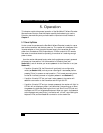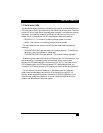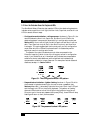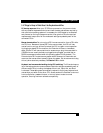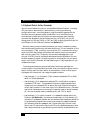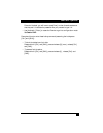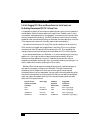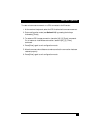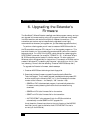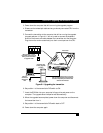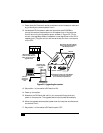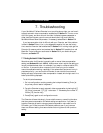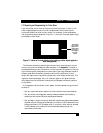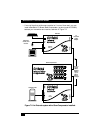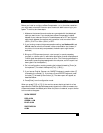
44
SERVSWITCH™ WIZARD EXTENDER
6. Upgrading the Extender’s
Firmware
The ServSwitch™ Wizard Extender uses flash-rewritable program memory, and you
can upgrade its firmware code by using a PC program to download new firmware
into the transmitter and receiver through their keyboard connections. (The
transmitter and receiver may be independently upgraded, but we highly
recommend that whenever you upgrade one, you also always upgrade the other.)
To perform a flash upgrade you will need to create an MS-DOS
®
boot disk for
the PC-compatible computer CPU that you’ll run the upgrade program on. This
boot disk is used to run the upgrade program automatically without the need for
keyboard control. On a CPU running DOS, a boot disk can be created using the
DOS FORMAT command (for example, “FORMAT A: /S”). In Windows
®
95 and
98, DOS boots disks can be created in a similar manner. For other versions of
Windows, refer to Windows Help for instructions. (For example, a DOS disk can be
created in Windows XP
®
by selecting My Computer, right-clicking on the “A:” disk
icon, selecting “Format” and then selecting “Create an MS-DOS startup disk.”)
To upgrade the Extender’s firmware, take these steps:
1. Create an MS-DOS boot disk using a blank floppy disk.
2. Download the latest firmware upgrade files as directed by Black Box
Technical Support. The firmware upgrade is available as a compressed ZIP
archive containing the following files (“xxx” in the filenames is the version
number of the firmware — for example, “108” is version 1.08):
– SSWEDxxx.EXE is the download program; it automatically selects the
firmware to use by detecting the module that is connected during
download.
– SSWERxxx.HEX is the firmware file for the receiver.
– SSWETxxx.HEX is the firmware file for the transmitter.
– AUTOEXEC.BAT is the autoexec file for the DOS boot disk that
automatically runs the SSWEDxxx.EXE upgrade file.
Unzip these four files and copy them to the root directory of the MS-DOS
boot disk (you will need to overwrite the AUTOEXEC.BAT file that is
currently on the DOS disk).



